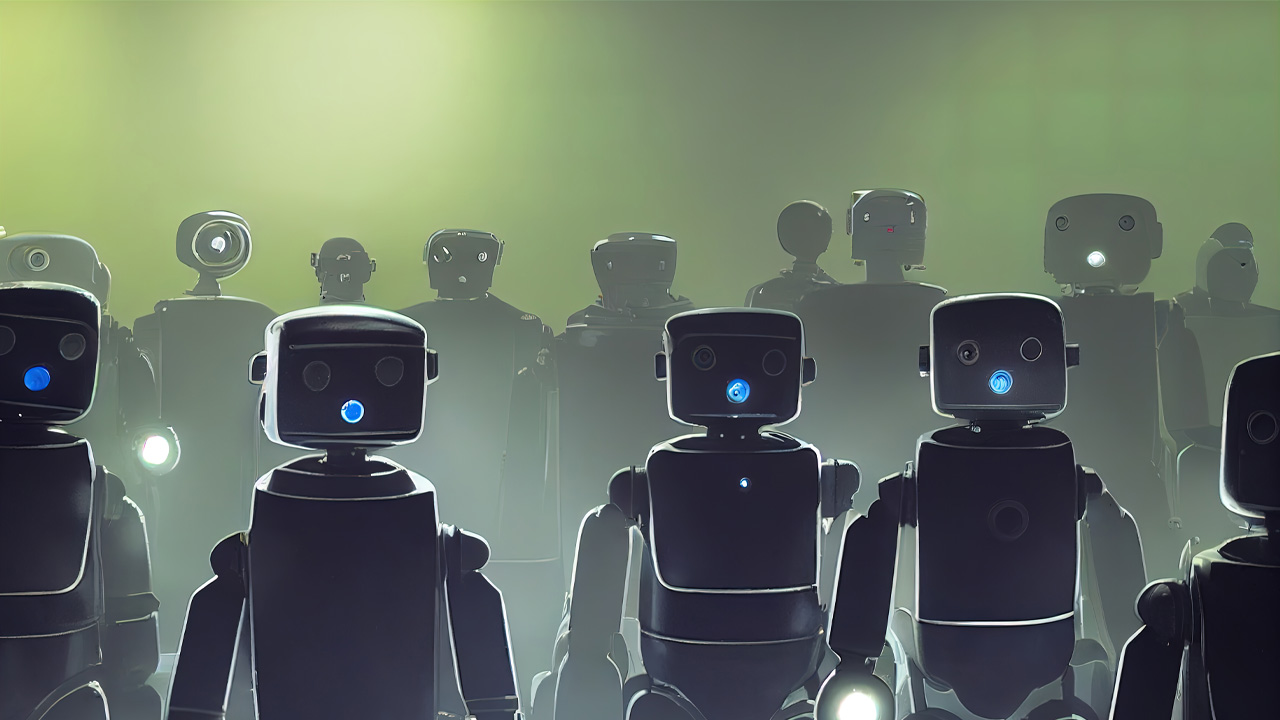Step into the robot lab of tomorrow and be transported to a futuristic frontier where science meets innovation. In this cutting-edge facility, the boundaries of technology are pushed, and the possibilities of the future are explored. With advancements in AI, robotics, and automation, this lab is at the forefront of creating machines that are revolutionising industries and enhancing human lives.
Imagine witnessing robots performing complex surgeries with precision and accuracy, or interacting with AI-powered companions that understand and respond to your every need. This is not science fiction; it is the reality being shaped by the brilliant minds in this state-of-the-art lab.
Through relentless experimentation and groundbreaking research, this facility is paving the way for a world where robots seamlessly integrate into our daily lives. From manufacturing and logistics to healthcare and entertainment, these robots are poised to transform industries as we know them.
Join us as we delve into the fascinating world of the robot lab of tomorrow and discover the incredible technologies that are bringing us one step closer to a future where science fiction becomes science fact.
The Evolution of Robotics
Since the inception of robotics, technology has come a long way. Robotics has evolved from simple automation to sophisticated systems that mimic human behavior and intelligence. Over the years, robots have become more capable, versatile, and adaptable.
The early days of robotics saw the development of basic machines that could perform repetitive tasks in manufacturing. However, with advancements in AI and machine learning, robots are now capable of complex cognitive tasks. They can process large amounts of data, learn from it, and make decisions in real-time.
Moreover, robots are no longer confined to industrial settings. They have found their way into various fields such as healthcare, logistics, entertainment, and even personal assistance. The evolution of robotics has opened up a world of possibilities, with the potential to transform industries and improve our daily lives.
The Impact of Robots on Various Industries
The impact of robots on various industries cannot be overstated. They have revolutionized manufacturing processes, improving efficiency and productivity. Robots can perform tasks with speed and accuracy, reducing errors and minimizing downtime. This has led to significant cost savings for companies and increased competitiveness in the market.
In the healthcare industry, robots have played a crucial role in assisting doctors and surgeons. They can perform complex surgeries with precision, reducing the risk of human error. Robotic assistants have also been developed to provide support in rehabilitation and elderly care, enhancing the quality of life for patients.
Logistics is another industry that has benefited greatly from robotics. Automated warehouses and delivery systems have transformed the way products are stored, sorted, and shipped. Robots can navigate through warehouses, pick and pack items, and even load them onto trucks, streamlining the entire process.
Entertainment is yet another sector that has embraced robotics. From animatronic characters in theme parks to humanoid robots in interactive exhibits, robots have brought a new level of excitement and engagement to the entertainment industry. They can entertain, educate, and even perform alongside humans, creating immersive experiences for audiences.
The Benefits of Investing in Robotics Research and Development
Investing in robotics research and development offers numerous benefits for companies and society as a whole. By developing cutting-edge technologies and innovations, businesses can gain a competitive edge in the market. Robotics can improve efficiency, reduce costs, and enhance the overall quality of products and services.
Moreover, robotics research has the potential to solve some of the world’s most pressing challenges. From addressing labor shortages in industries to providing solutions for aging populations, robots can fill critical gaps and improve the lives of people around the globe. Investing in robotics is not just an investment in technology; it is an investment in a better future.
Exploring the Robot Lab of Tomorrow
As we step into the robot lab of tomorrow, we are greeted by a flurry of activity. Engineers and scientists are busy working on various projects, each pushing the boundaries of technology in their respective fields. The lab is equipped with state-of-the-art equipment and facilities, enabling the development and testing of cutting-edge robotics technologies.
One corner of the lab is dedicated to humanoid robots. These robots are designed to mimic human movements and interact with their surroundings. With advanced sensors and actuators, they can navigate through complex environments, manipulate objects, and even communicate with humans using natural language processing.
Another section of the lab is dedicated to medical robotics. Here, researchers are developing robotic systems that can assist doctors in surgeries, diagnostics, and rehabilitation. These robots are equipped with advanced imaging technologies, precise surgical instruments, and AI algorithms that can analyze medical data in real-time.
In yet another area, logistics robots are being developed. These robots can navigate through warehouses, identify and pick items, and optimize the movement of goods. Using AI algorithms, they can learn from past experiences and continuously improve their efficiency and performance.
Cutting-Edge Robotics Technologies and Innovations
The robot lab of tomorrow is at the forefront of cutting-edge robotics technologies and innovations. Researchers are constantly pushing the boundaries of what robots can do, exploring new materials, algorithms, and design principles.
One of the key areas of research is in the field of soft robotics. Soft robots are made from flexible materials that mimic the properties of biological tissues. These robots can adapt to their environment, squeeze into tight spaces, and interact with delicate objects without causing damage. Soft robotics has the potential to revolutionize industries such as healthcare, where gentle interactions with patients are crucial.
Another exciting area of research is swarm robotics. Swarm robots are small, autonomous robots that work together in a coordinated manner to achieve a common goal. Inspired by the behavior of social insects, these robots can perform tasks that are beyond the capabilities of individual robots. Swarm robotics has applications in areas such as search and rescue, agriculture, and exploration.
Furthermore, researchers are exploring the potential of bio-inspired robotics. By studying the principles of biology, scientists are developing robots that can mimic the locomotion and behavior of animals. These robots can navigate challenging terrains, adapt to changing conditions, and perform tasks that were previously impossible for traditional robots.
The Potential Applications of Robots in Everyday Life
The potential applications of robots in everyday life are vast and varied. In the near future, we can expect to see robots playing a significant role in our daily lives, enhancing our productivity, convenience, and well-being.
In the healthcare sector, robots can assist in patient care, monitoring vital signs, and administering medications. They can provide companionship and support for the elderly, helping them with daily tasks and ensuring their safety. Robots can also be used in home automation, controlling household appliances and systems to create a more comfortable and efficient living environment.
In the transportation industry, self-driving cars and autonomous vehicles are set to revolutionize the way we travel. These vehicles can navigate through traffic, communicate with each other, and make real-time decisions to ensure safe and efficient transportation. With autonomous vehicles, commuting becomes more convenient, and road accidents can be significantly reduced.
Robots also have the potential to transform the education sector. They can act as interactive tutors, providing personalized learning experiences for students. Robots can adapt to individual learning styles, answer questions, and provide feedback, making education more engaging and effective.
Challenges and Concerns in the Development of Robots
While the development of robots brings great promise, it also presents challenges and concerns that need to be addressed. One of the main concerns is the impact of robots on the job market. As robots become more capable and versatile, there is a fear that they will replace human workers, leading to job displacement and unemployment. However, experts argue that while certain jobs may be automated, new job opportunities will also arise as a result of robotics.
Another concern is the ethical implications of robotics. As robots become more intelligent and autonomous, questions arise regarding their decision-making capabilities and accountability. Issues such as privacy, security, and bias in AI algorithms need to be carefully considered and regulated to ensure the responsible development and use of robots.
Additionally, there are concerns about the potential misuse of robotics technologies. Robots can be used for malicious purposes, such as surveillance, hacking, or even physical harm. Strict regulations and safeguards need to be put in place to prevent misuse and ensure that robots are used for the benefit of society.
The Future of Robotics and Its Implications for Society
The future of robotics is filled with endless possibilities. As technology continues to advance, robots will become more integrated into our daily lives, transforming industries and redefining the way we live and work. However, this future also brings with it important considerations and implications for society.
For one, the widespread adoption of robotics may lead to a shift in the job market. While certain jobs may be automated, new job opportunities will arise in fields such as robotics engineering, programming, and maintenance. It is crucial for individuals and industries to adapt and upskill to stay relevant in this changing landscape.
Furthermore, the ethical implications of robotics need to be carefully addressed. Regulations and guidelines must be put in place to ensure the responsible development and use of robots. Transparency and accountability are essential to build trust between humans and robots and ensure that they are used for the greater good.
Conclusion: Embracing the Future of Robotics
In conclusion, the robot lab of tomorrow is a testament to the incredible advancements in robotics and AI. It is a place where science fiction becomes science fact, and the possibilities of the future are realized. Robots are no longer confined to the realm of imagination; they are here, and they are transforming industries and enhancing human lives.
As we embrace the future of robotics, it is important to remember that robots are tools that can amplify human capabilities and improve our quality of life. By investing in robotics research and development, we can unlock the full potential of this technology and create a future where humans and robots coexist harmoniously.
So, step into the robot lab of tomorrow and witness the incredible technologies that are shaping the future. Be inspired by the brilliant minds pushing the boundaries of what is possible. The futuristic frontier is here, and it’s waiting for you to explore.





